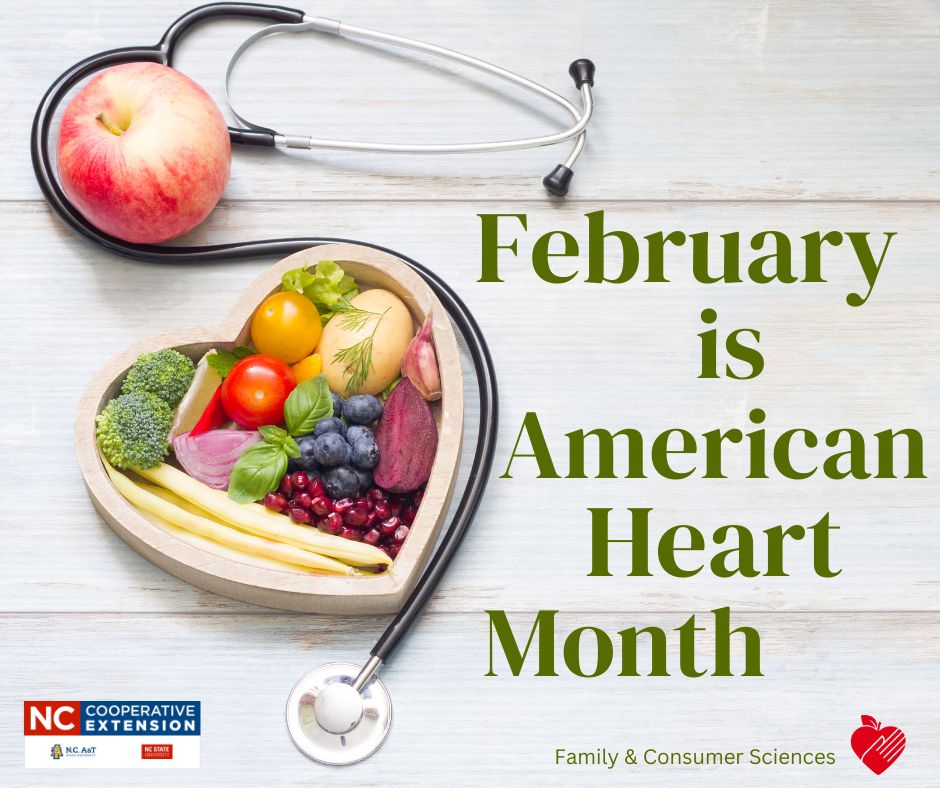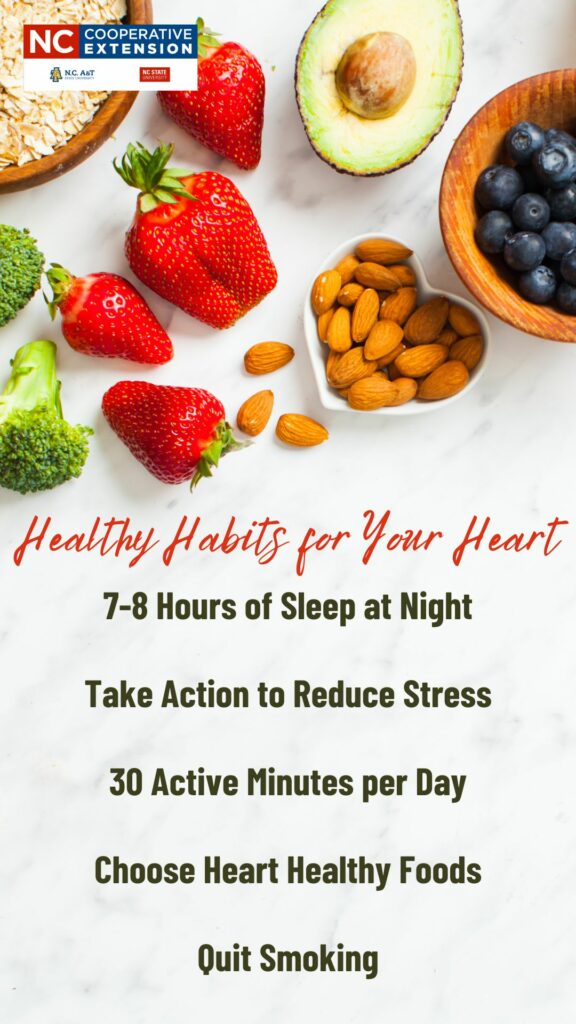Healthy Habits for Your Heart
go.ncsu.edu/readext?915107
en Español / em Português
El inglés es el idioma de control de esta página. En la medida en que haya algún conflicto entre la traducción al inglés y la traducción, el inglés prevalece.
Al hacer clic en el enlace de traducción se activa un servicio de traducción gratuito para convertir la página al español. Al igual que con cualquier traducción por Internet, la conversión no es sensible al contexto y puede que no traduzca el texto en su significado original. NC State Extension no garantiza la exactitud del texto traducido. Por favor, tenga en cuenta que algunas aplicaciones y/o servicios pueden no funcionar como se espera cuando se traducen.
Português
Inglês é o idioma de controle desta página. Na medida que haja algum conflito entre o texto original em Inglês e a tradução, o Inglês prevalece.
Ao clicar no link de tradução, um serviço gratuito de tradução será ativado para converter a página para o Português. Como em qualquer tradução pela internet, a conversão não é sensivel ao contexto e pode não ocorrer a tradução para o significado orginal. O serviço de Extensão da Carolina do Norte (NC State Extension) não garante a exatidão do texto traduzido. Por favor, observe que algumas funções ou serviços podem não funcionar como esperado após a tradução.
English
English is the controlling language of this page. To the extent there is any conflict between the English text and the translation, English controls.
Clicking on the translation link activates a free translation service to convert the page to Spanish. As with any Internet translation, the conversion is not context-sensitive and may not translate the text to its original meaning. NC State Extension does not guarantee the accuracy of the translated text. Please note that some applications and/or services may not function as expected when translated.
Collapse ▲
Cardiovascular disease is a leading cause of death in the United States for both men and women. Understanding your risk and making healthy choices, are just some of the many things we can do to protect our heart and stay healthy.
Understanding Your Risk
According to the National Institute of Health(NIH), cardiovascular disease is the term for all types of diseases that affect the heart or blood vessels, including coronary heart disease (clogged arteries), which can cause heart attacks, stroke, heart failure, and peripheral artery disease.
Risk factors for Heart Disease:
- High Blood Pressure
- High Blood Cholesterol
- Overweight or Obesity
- Pre-diabetes or Diabetes
- Smoker
- Inactive or Sedentary
- Family History of Heart Disease
- History of Preeclampsia
- Unhealthy eating behaviors
- Women 55 or older or age 45 or older for men
You should talk with your doctor about your heart health and have an annual check up. It is a good idea to write down any questions you may have before your appointment so that you do not forget to ask. If you have been diagnosed with a cardiovascular disease, work with your medical provider to develop a treatment plan.
Making Heart Healthy Choices
The foods we eat and the lifestyle choices we make contribute to our heart health. We are unable to change certain risk factors such as our age, sex, or a family history of heart disease, but by focusing on the things that we can change, we can gradually begin to lead a more heart healthy lifestyle.
Food Choices
Eating a diet low in sodium and saturated fat is an actionable step to heart disease prevention. Tropical oils (coconut and palm) as well as solid fats such as butter, lard, shortening, and hard stick margarine are often a source of saturated fat. It is recommended to choose an oil that is lower than 4 grams of saturated fat per tablespoon, and no partially hydrogenated oils or trans fats. Other sources of saturated fat that you should consider limiting are beef, lamb, pork, poultry (especially with skin), beef fat (tallow), cream, cheese, ice cream, and fried foods.

The American Heart Association (AHA) reports that 97% of Americans do not know or underestimate their sodium intake. An ideal sodium limit according to the AHA is 1,500 mg per day for adults. Therefore be selective when choosing packaged, processed foods, canned items or condiments (soy sauce, ketchup, salad dressings etc.) as they are often high in sodium. Look for low sodium versions and compare nutrition labels between brands to pick the item with the lowest sodium level.
For recommendations that include a well rounded diet please check into MyPlate from the USDA and the DASH eating plan. Studies on the DASH diet have shown a decline in blood pressure in as little as two weeks and lower low-density lipoprotein (LDL or “bad”) cholesterol levels in the blood. Elevated blood pressure and high LDL cholesterol levels are both significant risk factors for heart disease.
Getting More Movement
The benefits of physical activity are numerous including reduced stress, improved sleep, improved mood and surprisingly more energy! It is recommended that Americans get at least 150 minutes of moderate intensity aerobic activity or 75 minutes of vigorous aerobic activity per week. Consider adding a muscle strengthening activity twice per week such as resistance or weight training. Even light activity is better than being sedentary and as you begin to move more, you will find greater ease in starting to increase your intensity and amount of exercise.
Manage Stress and Improve Sleep
Certain types of stress have been found to elevate blood pressure levels. Reducing stress can seem like a daunting task, however there are small steps you can take to make it easier. We previously discussed how physical activity can reduce stress, but you may also consider things such as exploring mindfulness and meditation, taking a few slow, deep breaths, or spending time doing something you enjoy to decrease the stress in your life.
For other ways to manage stress check out these tips.
Improving your sleep related habits is an excellent way to decrease stress, and get an improved quality of rest. Establishing a routine before bed and sticking to a set sleep schedule to get 7-8 hours of sleep per night (even on the weekend) are great ways to improve your ability to fall asleep faster and wake up easier each day. Consider avoiding caffeine in the hours before bed and disconnect from electronic devices at least one to two hours before you want to fall asleep. Studies have found that the blue light on your phone mimics daylight and can decrease melatonin levels and can disrupt your circadian rhythm.
Smoking Cessation
Chemicals in cigarette smoke cause the cells that line your blood vessels to become inflamed and swollen. This narrowing of the blood vessels in your body can increase your risk of cardiovascular disease. Even those smoking 5 or less cigarettes per day have the twice the risk of dying from heart/blood vessel disease compared to nonsmokers.
Chemicals in Tobacco Smoke:
- Nicotine: An addictive stimulant that causes increased heart rate and higher blood pressure, which increases the risk of a heart attack.
- Carbon Monoxide: A poisonous gas that replaces the oxygen in your blood, decreasing the oxygen supply to your heart and other organs
- Tar: A sticky substance that covers the inner lining of your lungs and contains various chemicals that cause cancer
A National Institute of Health study found that chronic electronic cigarette users had impaired blood vessel function. An unexpected find in this study was that potentially, there was an even higher risk for heart disease when a smoker combined using both cigarettes and e-cigarettes.
For free resources to quit smoking please visit: smokefree.gov or by calling 1-800-QUIT-NOW

Additional Resources:
For more information about Healthy Lifestyles and Nutrition, contact Marlana Baker, Family and Consumer Sciences Agent, at marlana_baker@ncsu.edu or 828.837.2210 extension 5.




